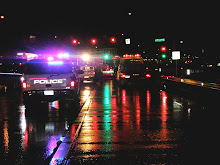Capillaries: your cells need gases, nutrients and hormones to survive... and these microscopic blood vessel wonders deliver. The average capillary has such a small internal diameter that red blood cells are just able to march through it in single file. They are the transition from arterial blood flow to venous blood flow.
Capillaries are not lone rangers, however. They work together in interweaving systems called capillary beds. These capillary beds are more complex than one might think. Mechanisms at play in the capillary beds contribute to many of the skin signs we see in hypovolemic shock... pallor, coolness, clamminess, blueness.
You may recall that in a hypovolemic state, the body will shunt blood away from the surface and into the core, where vital organs are located. When faced with limited resources (blood) the body says "screw you skin, we're giving this stuff to the organs that really count." But how does the body actually do this shunting stuff? Vasoconstriction is far from a complete answer. Much of this action goes down in the capillary beds themselves.
 Okay, don't be intimidated by the crazy diagram I made in paint. We'll start left to right, which is the direction that blood flows. The capillary bed is fed by the terminal arteriole, a baby artery. Blood passes into the metarteriole, the intermediate between an arteriole and capillary. The metarteriole is continuous with the thoroughfare channel, the intermediate between a capillary and a venule. Blood flows from the thoroughfare channel into the postcapillary venule, which is a baby vein. This is obviously a direct route, so what about that crazy web of capillaries?
Okay, don't be intimidated by the crazy diagram I made in paint. We'll start left to right, which is the direction that blood flows. The capillary bed is fed by the terminal arteriole, a baby artery. Blood passes into the metarteriole, the intermediate between an arteriole and capillary. The metarteriole is continuous with the thoroughfare channel, the intermediate between a capillary and a venule. Blood flows from the thoroughfare channel into the postcapillary venule, which is a baby vein. This is obviously a direct route, so what about that crazy web of capillaries?The capillaries in that web are known as true capillaries, and they branch off of the metarteriole. So those green things in my diagram, the precapilllary sphincters? Those are simply cuffs of smooth muscle that surround the root of every true capillary. When these sphincters are relaxed and open, blood flows freely into the true capillaries and can make exchanges with tissue. When these sphincters are contracted and closed, blood cannot flow into the true capillaries and is forced to take the direct route (terminal arteriole > metarteriole > thoroughfare channel > postcapillary venule) and bypass the surrounding tissues.
To give you a better picture, imagine that the above diagram has the precapillary sphincters open and all the color in the true capillaries represents blood flowing. Here's what the diagram would look like with the precapillary sphincters closed:
 When the body is responding to a condition such as hypovolemic shock, it tries to compensate and keep the blood pressure up. In addition to shunting blood to vital organs, widespread vasocontriction will occur, keeping BP up and increasing venous return. The body can keep this act up for a remarkable amount of time and maintain a stable BP, which is why a decreased BP is an ominous sign in someone in shock. The body is failing to compensate for the loss of blood volume and organ damage and/or death is likely to occur due to immense hypoperfusion. Any questions?
When the body is responding to a condition such as hypovolemic shock, it tries to compensate and keep the blood pressure up. In addition to shunting blood to vital organs, widespread vasocontriction will occur, keeping BP up and increasing venous return. The body can keep this act up for a remarkable amount of time and maintain a stable BP, which is why a decreased BP is an ominous sign in someone in shock. The body is failing to compensate for the loss of blood volume and organ damage and/or death is likely to occur due to immense hypoperfusion. Any questions?Reference:
Marieb, E. N., & Hoehn, K. (2007). Human Anatomy and Physiology (7th ed.).
San Francisco: Pearson Benjamin Cummings


1 comment:
I'm loving the paint diagrams! So much better than what my AP Bio books had to offer way back in the day, haha!
Post a Comment